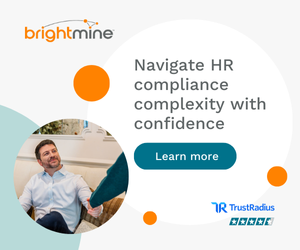Top 5 HR Compliance Priorities for 2025
Posted on 04-22-2025, Read Time: 6 Min
Share:


Introduction
Actions and executive orders by the Trump administration have caused significant policy shifts across a broad range of employment laws. These changes make it essential for HR professionals to remain vigilant and adaptable to ensure compliance with complex and varied federal, state and local requirements in the evolving legal landscape.Of course, each area presents unique challenges. These compliance priorities demand strategic planning and proactive management from HR professionals to mitigate risks and align with legal standards.
EEO and DEI
Always a high priority, compliance with equal employment opportunity (EEO) law has become even more crucial for HR professionals in 2025 amid significant policy shifts under the current administration. Changes like ending affirmative action requirements for federal contractors, rescinding Biden-era guidance on sexual harassment and gender identity and the signing of executive orders and memos targeting “illegal” diversity, equity and inclusion (DEI) initiatives signal a departure from traditional EEO norms. As a result, HR must navigate a complex environment where federal, state, and local laws vary significantly.Despite these changes, federal laws under Title VII, the Age Discrimination in Employment Act, Americans with Disabilities Act and Equal Pay Act remain in force, obliging employers to maintain a discrimination-free workplace. It's crucial for HR professionals to navigate these shifts without altering their commitment to providing equal opportunities. And while affirmative action requirements for most contractors have been eliminated, employers must still ensure compliance with state and local mandates.
Additionally, DEI programs must avoid unlawful employment actions based on protected characteristics. HR professionals need to audit and refine their DEI strategies and ensure that their policies promote inclusivity while avoiding potentially discriminatory practices. By strategically refining DEI language and initiatives, employers can promote diversity and inclusion without contravening current legal guidelines.
Immigration
Always a compliance priority, Immigration issues have become even more critical for HR professionals due to policy shifts under the Trump administration. The renewed focus on Form I-9 compliance and expected increase in audits and enforcement activities requires careful review and strict adherence to immigration documentation procedures. Additionally, heightened scrutiny of employment-based visa programs, like H-1B visas, can restrict employers' access to international talent, requiring HR to reevaluate and adapt workforce planning strategies.Moreover, the introduction of several executive orders related to immigration enforcement and security screening emphasizes the need for employers to prepare for intensified inspections and audits. This could include enhanced workplace enforcement by US Immigration and Customs Enforcement and potential disruptions in business travel due to increased visa-processing times and travel bans.
In response, HR professionals must proactively design strategies to ensure compliance, such as conducting Form I-9 self-audits and establishing raid response plans, while also developing contingency plans for employees who could be impacted by restrictive travel policies.
Wage and Hour
Wage and hour issues are critical compliance priorities in 2025 due to their regulatory complexity and significant legal liability. Misclassification of employees – both distinguishing between independent contractors and employees and differentiating between overtime exempt and non-exempt workers – remains a significant concern. This is due to ongoing regulatory changes, such as the Department of Labor’s activities surrounding independent contractor rules, which can significantly impact compliance strategies. Classification impacts various taxation, workers’ compensation, and unemployment insurance requirements, necessitating clear understanding to be fully compliant.Ensuring adherence to Fair Labor Standards Act rules and standards is vital to avoid liability. Addressing off-the-clock work and unauthorized overtime is one challenge, especially in light of remote working trends. Overtime violations, including improper calculation of regular rates and incorrectly categorizing non-work time, can lead to costly penalties and lawsuits. Policies need to be thoroughly communicated and monitored to prevent errors and maintain compliance.
Pay Transparency
Pay transparency laws have emerged as a compliance priority for HR professionals as they continue to proliferate, with laws now on the books in 14 states, DC and several localities, with more legislation in the pipeline. In the era of remote work, the reach of these laws extends beyond the borders of the states that have enacted them.HR professionals in multistate organizations, in particular, face challenges in maintaining compliance amid diverse disclosure requirements, which can include salary ranges, benefits and specific compensation practices. The complexity and variability in pay transparency laws necessitate a structured approach to monitor legal updates and ensure adherence to the strictest regulations, especially for remote or multistate roles.
Adopting common pay transparency practices can mitigate compliance risks and optimize recruitment processes. By staying ahead of legal requirements, employers can enhance their talent acquisition strategies while avoiding penalties associated with noncompliance. For HR professionals, the dual benefits of compliance and improved recruitment efficiency underscore the importance of prioritizing pay transparency laws.
Paid Leave
Paid leave laws have become an increasingly complex compliance priority for HR professionals due to their growing number and frequent amendments. Given the absence of a federal paid family leave mandate, states actively legislate to safeguard employee rights across medical, family and military exigency leaves. A significant focus is on ensuring sick leave protections.Employers should maintain awareness of evolving leave laws, including those addressing sensitive issues like protections for victims of violence. The increasing employee-friendly laws underscore the importance for HR professionals to develop comprehensive plans to navigate varied state laws efficiently. Strategies to ensure compliance involve monitoring legal developments, facilitating HR training for handling sensitive leave issues, and aligning workforce policies with emerging regulations.
Conclusion
As the employment law situation continues to evolve in 2025, HR professionals must strategically prioritize compliance to address emerging challenges effectively. Staying informed of legal requirements across EEO and DEI, immigration, wage and hour issues, pay transparency and paid leave is crucial. Adapting to these shifts ensures that HR can mitigate risks, enhance workforce planning, and maintain compliance with both existing and new regulations.Error: No such template "/CustomCode/topleader/category"!


